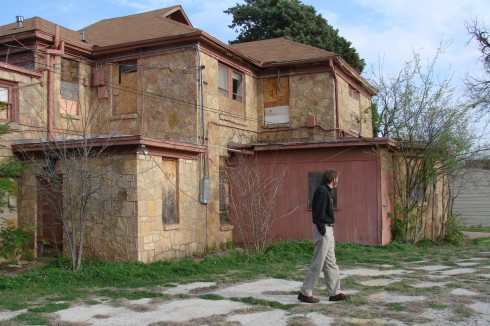This is the first draft of my contextual theology paper for Stephen Johnson’s Contexts of Ministry class. I include it as an artifact here in my portfolio to represent progress towards outcomes 3bc, 4d, and 11d.
This paper is my beginning attempt to set forth an understanding of what contextual theology is. I start from my own definition of theology (taken from an assignment for Fred Aquino’s Systematic Theology class last fall). I then proceed to talk about how contextual theology is theology incarnate, and I discuss what exactly that means for our practice of theology. I also draw on a few assigned readings and experiences from the class, incorporating the insight I received from them into my own explication of contextual theology (4d). This paper, while not engaging a specific context, does lay the groundwork for that kind of endeavor in the future, so I believe that it shows progress towards outcome 3 (specifically indicators 3b and 3c).
While there is still more work to be done when it comes to formulating a firm interpretation of what contextual theology is and means in my life, this paper does provide a springboard for that kind of work to be done. This assignment was an extremely helpful one for me because it challenged me to define and articulate what I understand contextual theology to be. That will be helpful not only during my studies at ACU but throughout the rest of my life in ministry, I believe. It will give me a place from which to orient myself as I carry out contextual ministry and therefore contextual theology as well.
The paper seems to me, at least, to be well written (11d). This impression was confirmed by Dr. Johnson, who assigned it a 92/100 and commented, “Very well written reflection. I appreciate the care with which you have articulated a theology rooted in time, place, and practice.” Dr. Johnson pointed out a few areas for improvement as well, which I will be sure to focus on when I revise the paper towards the end of the semester.
Here is the text of the paper:
Contextual theology, to the best of my ability to comprehend and verbalize at this point in my academic and ministry career, is essentially theology incarnate. To borrow from Eugene Peterson’s language, contextual theology is theology that has become “flesh and blood and moved into the neighborhood” (John 1:14, The Message).
Attempting to set aside the contextual aspect for just a moment, theology is, by my own definition, human attentiveness to mysteries pertaining to and revealed by God, entailing discernment as to what those unfolding mysteries indicate about and demand from the faithful. It follows, then, that because God is the one doing the revealing, and because the mysteries of God are always revealed to people located within specific historical, personal, and cultural settings, no “pure” form of theology exists apart from context, at least not to us as human beings. Perhaps for God, but not for those of us to whom God has revealed Godself. In that way, then, it is not truly possible to lay aside the idea of context when speaking of theology. All theology is contextual theology.
That is not to say, however, that all contextual theology is created equal. Some theology is only contextual in the limited sense of the above definition. Some of it, though, is contextual in a much deeper, much more committed way. This kind of contextual theology is theology in an earnest attempt to take on flesh. It is theology that engrosses its devotees in the amazing yet often disheveled world that God has created. It is theology that has abandoned its sheltered existence in academic isolation and has “moved into the neighborhood” of the real lives of real people. The embodiment of theology in concrete contextual settings means that theology is no longer theology in theory only, merely an intellectual exercise of systematizing knowledge about God. Rather, theology is lived out in a particular place and time among a particular people. This kind of contextual theology is also practiced in particular ways.
For one, contextual theology is just that: contextual. It takes into account and is informed by the cultures and contexts within which it is located. In their chapter entitled “Theological Thinking as Contextual Practice,” Brelsford and Senior assert that theological thinking “is not ex nihilo ideation; rather, thinking is always a project of reconstruction of preexisting assumptions and perceptions formed from the material of tradition, history, and experience” (42). Their statement applies to contextual theology as much as it does to theological thinking. Contextual theology does not emerge from nowhere, and it does not proceed into nowhere. Rather, it is birthed in the interaction of the traditions, histories, and experiences of specific individuals and communities, and it engages those same traditions, histories, and experiences even as it exists among them.
Secondly, and closely related, theology applied in context will always involve others. Brelsford and Senior also claim that theological thinking is far more of a communal pursuit than an individualistic one. Again, I would argue that the same is true for contextual theology. Although I suppose it is possible for one person to receive, interpret, and apply theological insights in his or her own individual life, even this undertaking in the limited sense of contextual theology would be a communal one insofar as no human being has lived in total isolation from the outside world for the entirety of life. More to the point, however, a contextual theology is a theology formed through interaction with a certain people and/or lived out among those certain people. So whatever way you look at it, contexts are always contexts that involve others in one fashion or another.
Furthermore, the relationship of theology and context in contextual theology is a mutual one, for the association serves two purposes simultaneously. Locating theology in context not only makes theology more contextually driven, but it also makes contexts more theologically intelligible. So while theology is challenged and strengthened by context, being focused and streamlined to reflect a particular experience, that experience can be brought further into the light of a growing understanding of who God is and how God is at work, allowing the people in that context to interpret their situation theologically. Take, for example, the Martin Luther King, Jr. Day march earlier this year. Theology shaped participation in this event in a number of ways. First of all, a certain theological understanding of human personhood and what it entails led to the crisis of extreme racial injustices that were being protested. Secondly, theology helped fuel the Civil Rights Movement and its most notable leader who was being celebrated that day. And personal theologies (ever-present even if subconscious) led to my and others’ participation in the rally and march. At the same time, however, our participation shaped our theology. Seeing people coming together to stand up for justice and claim that God supports their cause might lead me to consider the idea that justice might be something of great importance to God. And perhaps, if it really is important to God, it should also be important to me and to us as a community. Rather than existing as a set of two monologues, in which theology speaks to context and context replies with its own lecture for theology, however, this kind of contextual theological development is a dialogical process. The two resources of theology and context inform each other in a deliberately interactive way; give and take occurs between the two, and a discussion in the hopes of learning and transformation continues until a balance is struck and communion is found.
Finally, the dialogue of contextual theology follows a certain kind of procedure. While the exact details of the process will vary some from situation to situation (for what else is to be expected of a contextual theology?), the method remains basically the same: a contextual theology must engage its context, and it must interpret its context.
Engaging a context can take on various forms, some more integrated in that context than others. At the very least, engaging a context requires presence. Whether physically, relationally, intellectually, ideologically, or in some other way, one must be present to a context in order to engage it. The next step, once that necessary presence has been established, is to engage the context by devoting attention to it. This begins with simple observations about who is (or is not) there and what is (or is not) happening in the context. In her chapter on attention, Barbara Brown Taylor reminds us that “the practice of paying attention is as simple as looking twice at people and things you might just as easily ignore” (34). And beginning from this simple foundation of looking twice, paying attention can draw an observer into a context in even greater ways, leading her or him to ask the question, “Why?” It is at this point that aspects of interpretation come into play, but before moving on to those, we must look at one further aspect of engaging a context: interaction. Appropriate interaction with a context is key to engaging that context well. While in some situations, the only appropriate interaction is that of presence and attentive observation, in other settings, one may ask questions of those present or even participate in the context’s rhythms oneself. The level at which one is allowed to interact with a context in an approved of way can sometimes be sensed intuitively, but at other times the observer-participant might want to ask what would be considered appropriate.
Interpreting a context is generally more difficult than engaging it. While presence, attention, and interaction may be relatively straightforward for even an outsider, the history and meanings behind a context are often extremely complicated and are difficult to spell out without great care. Vanhoozer’s chapter, “What is Everyday Theology?” provides an excellent discussion of cultural hermeneutics that could also be applied to the hermeneutics of contextual theology. Vanhoozer admits that interpretation will be both messy and provisional, for, in his words, “Interpretation is not an exact science” (36). His categories of the worlds behind, of, and in front of cultural texts could well be applied to the process of interpreting contexts of theology. In other words, “Who made this [context] and why? What does it mean and how does it work? What effect does it have on those who receive, use, or consume it?” (48). And Vanhoozer also admits to the dialogical nature of context and theology, saying, “We don’t simply read cultural [or contextual] texts but we read through them. In short: the cultural [and contextual] texts we love best come to serve as the lens through which we view everything else and as the compass that orients us toward the good life” (36).
As we communally engage and interpret our contexts, making space to involve ourselves intricately in the dialogue between those contexts and theology, I believe that we will see a strong contextual theology developing. It will be one that allows us to observe the mysteries that God is revealing to us in a particular time and place, discerning both what those mysteries tell us about God and ourselves in that time and place and what they subsequently ask of us who live as God’s people in that time and place. This will not just be theoretical theology. This will be theology incarnate.





